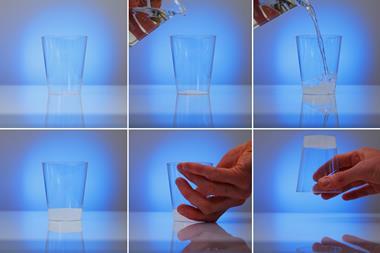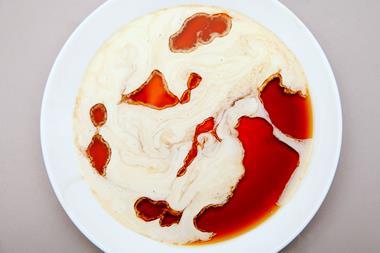I was once approached by a confused student who had produced copper oxide by decomposing copper carbonate. They had written their name on a label and stuck it on the tube of copper oxide. A few seconds later, their name vanished.
After some questioning, it turns out they had been using an 'erasable' pen that becomes colourless when the dye is heated by rubbing it. Their tube had not completely cooled before they stuck on the label. I was able to make their name reappear by sticking the tube in a freezer for a few minutes. This gave me an idea for an extension to a demonstration I do with microwaves and solvents.
In science lessons the microwave oven usually only serves to help calculate the speed of light or show the effect of microwaves on a light bulb. However it can also be used to illustrate concepts in chemistry.
A common experiment involves holding an electrostatically charged rod or balloon near to the streams from burettes filled with a variety of solvents. This demonstrates how polar the solvent is. You can perform a similar experiment to show how the polarity of a solvent affects how efficiently a microwave oven can heat it. This effect can be exploited by chemists allowing for more efficient heating of reactants in solution - reactions can often be far quicker and more selective under microwave conditions.
Kit
- Microwave oven
- 2 x 50 cm3 beakers
- 20 cm3 paraffin (also known as kerosene, harmful)
- 20 cm3 water
- Sticky labels
- Thermochromic 'erasable' pen (eg Pilot 'FriXion') or thermochromic mugs.
Safety
- While in theory any non-polar solvent will work, paraffin is particularly suitable for use in schools as it has a higher flashpoint
- Be careful not to super-heat water in the microwave oven
- Kerosene is an aspiration toxin
Preparation
The idea here is to show that the water will be heated in the oven but the paraffin will not. The heating time will depend on the exact quantity of liquid used and the power rating of your microwave. Somewhere between 30 seconds and 1 minute will be enough. Practise this in advance using insulating gloves and anti-bumping granules. Aim to reach a temperature above 60°C for the water, but well below boiling, as microwave heating carries with it the risk of superheating and the associated potential of scalding as the liquid boils over following nucleation.
In the past I have placed the two beakers in the microwave and then passed them around for the class to feel, but thermochromic inks provide a visual clue to what is happening too. The thermochromic ink will disappear when heated so I labelled the beakers 'not hot water' and 'not hot paraffin' respectively. The words are written in normal ink apart from the 'not', which is written in thermochromic ink.
In front of the class
Place approximately 20 cm3 of each liquid into their respective beakers and ask the students what they expect to happen. Many will suggest that it would be dangerous to put a fuel like paraffin into a microwave oven and may even predict that there will be an explosion.
After heating for the time you have determined, the water should have reached above 60°C, high enough to switch the ink to its colourless form, and its label will read 'hot water'. The other beaker will still read 'not hot paraffin'. Having first carefully tested the temperature of the beaker yourself, you can then offer them both for students to feel.
Alternative method
The beakers can be replaced by thermochromic mugs where a pattern appears when they are hot. Check the mug is microwave safe before you use it!
Teaching goal
In order for microwave ovens to heat a substance, the substance must contain particles that are free to move (eg in a fluid). If these particles have some anisotropy of charge, their orientation can be affected by an applied electromagnetic field.
Polar water molecules will try to align themselves with the oscillating field in a microwave. However the resistance caused by their intermolecular forces means they are always 'playing catch-up'. The resulting collisions as they stumble about lead to heating. Molecules that are not polar will not experience this force, and as such the paraffin will remain cool.


















No comments yet